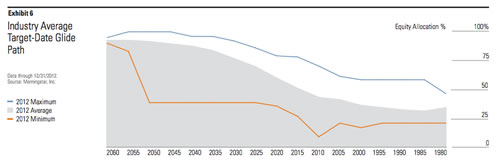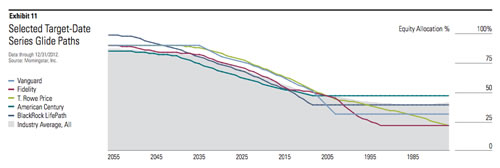Target date funds (TDFs) get their name because they adjust their portfolio holdings automatically over time based on a given target retirement date. In general, this means shifting from mostly stocks to less stocks over time (known as the “glide path”). TDFs continue to grow in popularity, especially within employer-based plans like 401k’s and 403b’s.
Morningstar Fund Research recently released its 2013 industry survey, Target-Date Series Research Paper [pdf]. While it feels targeted at financial professionals, there are some good nuggets for us individual investors looking to decide where to invest. For example, we have to be careful as look how widely the glide path can very between different brands of target funds:
While the most popular TDF providers have much more similar glide paths, they still differ in important ways (especially after retirement age).
Other highlights from the paper:
- The Big 3 are still Fidelity, Vanguard, and T. Rowe Price. Fidelity has 32% market share, Vanguard 26%, and TRP 17%. Fidelity has been losing market share due to poor performance from their actively-managed Freedom funds. I’d consider their Freedom Index series instead if available.
- Fees continue to fall, slowly. The asset-weighted average expense ratio was 0.91% in 2012, down from 0.99% in 2011 and 1.04% in 2008. This is due to both lowered expense ratios and also the shift of money into more passive funds (which are cheaper). I’d definitely avoid paying anything higher than average.
- Passive gaining on active. Although the majority of assets are still invested in actively-managed TDFs, 2012 was the first year that more money went into passively-managed funds than actively-managed funds. The trend continues.
- Asset allocation still important. Morningstar analyzed risk-adjusted past returns but found that “few managers have improved performance with the selections they’ve made beyond the funds’ asset allocation and expense.” Actively-managed funds will vary more in the short-term.
- Trend shift towards more international exposure. Funds on average have changed to a stronger weighting towards both international stocks and international bonds. Since 2005, the average 2040-dated fund now has gone from having 24% to 36% of their equities in international stocks.
- Longevity risk vs. market risk. A common question is whether having more or less stocks is better. Morningstar suggests you consider the decision as a trade-off between taking more longevity risk (not having enough when old) or more market risk (wilder price swings both ways). If you have more money you have the luxury of taking less longevity risk.


 The Best Credit Card Bonus Offers – March 2024
The Best Credit Card Bonus Offers – March 2024 Big List of Free Stocks from Brokerage Apps
Big List of Free Stocks from Brokerage Apps Best Interest Rates on Cash - March 2024
Best Interest Rates on Cash - March 2024 Free Credit Scores x 3 + Free Credit Monitoring
Free Credit Scores x 3 + Free Credit Monitoring Best No Fee 0% APR Balance Transfer Offers
Best No Fee 0% APR Balance Transfer Offers Little-Known Cellular Data Plans That Can Save Big Money
Little-Known Cellular Data Plans That Can Save Big Money How To Haggle Your Cable or Direct TV Bill
How To Haggle Your Cable or Direct TV Bill Big List of Free Consumer Data Reports (Credit, Rent, Work)
Big List of Free Consumer Data Reports (Credit, Rent, Work)
Speak Your Mind